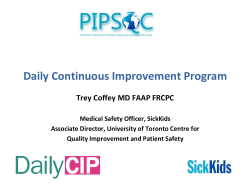
eCommerce Order Fulfillment 101 – a “how Sponsored by: Presented by:
eCommerce Order Fulfillment 101 – a “how to guide” of lean operational effectiveness Sponsored by: Presented by: Art Eldred Client Executive,Vargo Companies Tony Hollis Director of Engineering, Saddle Creek Corporation Six Sigma Black Belt 2013 MHI™ Copyright claimed as to audiovisual works of seminar sessions and sound recordings of seminar sessions. All rights reserved. Agenda • • • • • Retail ≠ eCommerce Origin of “lean” processes in manufacturing Push vs. Pull in the Distribution Center When is “Pull” ideal What are the barriers? Retail Push vs eCommerce Pull Best for Retail Stores Moves Mass Well Trailer Manifesting Balancing Act Trailer Routing Best for eCommerce Moves Dynamic Individuals Plan Well Parcel Manifesting Errors Errors Most Efficient Labor Easy to Are Push To Manage Costly Ideal Traditional Store Lower High “Pull Based” sINGLE “Push Based” Accuracy Accuracy dESTINATIONS DAILY PARCEL PLAN Requires Laborious a Pick , CARRIERS Silo’s Of Pick & Ship “Waveologist” Low Supervision PACK & Weight Automation Ship Capture HIGH FULL CASES#’S DEDICATED MAINTAINS HIGH PIECE LOW FULL LOW PIECE ROUTES BUSINESS PICK#’S CASES#’S PICK#’S Steady RULES! hIGHLY vOLATILE gROWTH High Supervision Growth PEAK “PEAK” Fixed Plan Origin of Lean in Manufacturing “Time waste differs from material waste in that there can be no salvage. The easiest of all wastes and the hardest to correct is the waste of time, because wasted time does not litter the floor like wasted material.” ~Henry Ford The Introduction of Lean Receiving Unit Pick Module(s) Reserve Storage Shipping PUSH Based Distribution Case Pick Module(s) IN Full Trailer & LTL OUT Full Trailer & LTL IN Full Trailer & LTL Shipping Manifesting Packing & VAS Receiving Random Carton Storage Order Assembly PULL Based Distribution OUT Individual Parcels The Pitfall of Waving The Benefit of Lean Retail Push vs. eComm Pull Traditional: Push/Wave • Chunks of work are planned for and managed; replenishment, picking, packing & shipping • The beginning and tail of a wave are least productive • Balancing labor with volume and product is difficult and seldom optimal • Warehouse management, control, picking and ship systems are often separate applications • Production is based upon fallible, static plans • Goals are pre-determined based upon management systems capabilities. • Slugs of work are “pushed” through the facility requiring the subsequent buffering of WIP • Exceptions are “pushed” out of the normal process for resolution – a silo eCommerce: Pull/Lean • Work is systemically released as orders are completed • Real-time data is shared across subsystems providing a continuous flow of work to the DC labor • Warehouse management, process control, exception handling, and ship systems are a continuous application • Production is based upon dynamically controlled objectives • Production output is controlled by optimal utilization of all resources • Identification and handling of exceptions is integral to the process • Units of work are “pulled” through the facility maintaining business rules • Business rules & exceptions aren’t obstructed by the mountain of work ahead in the queue When is Pull ideal? • High amount of active items • Large number or destinations/orders • Unpredictable order volumes • Varying degrees of business rules and priorities What’s taking the DC so long to implement a total lean solution? • Lean has been implemented in silos • Our information systems don’t really work in concert • The ReBirth of eCommerce • Lack of lean experts for our industry Path Forward "It takes great effort to follow the rules of a pull system ... thus a half-hearted introduction of a pull system brings a hundred harms and not a single gain." ~Taiichi Ohno, Toyota For More Information: Speaker: Art Eldred (aeldred@vargomail.com) Home Page: www.vargocompanies.com Visit ProMat 2013 Booth 4141 2013 MHI™ Copyright claimed as to audiovisual works of seminar sessions and sound recordings of seminar sessions. All rights reserved.
© Copyright 2025




![Chapter 3 Homework Review Questions Lesson 3.1 [pp. 78 85]](http://cdn1.abcdocz.com/store/data/000248451_1-668327adcad67c478c93f46227ffd100-250x500.png)
















